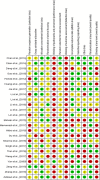Preclinical relevance of probiotics in type 2 diabetes: A systematic review
- PMID: 32608551
- PMCID: PMC7370849
- DOI: 10.1111/iep.12359
Preclinical relevance of probiotics in type 2 diabetes: A systematic review
Abstract
Type 2 diabetes (T2DM) is among the most prevalent metabolic diseases in the world and may result in several long-term complications. The crosstalk between gut microbiota and host metabolism is closely related to T2DM. Currently, fragmented data hamper defining the relationship between probiotics and T2DM. This systematic review aimed at investigating the effects of probiotics on T2DM in animal models. We systematically reviewed preclinical evidences using PubMed/MEDLINE and Scopus databases, recovering 24 original articles published until September 27th, 2019. This systematic review was performed according to PRISMA guidelines. We included experimental studies with animal models reporting the effects of probiotics on T2DM. Studies were sorted by characteristics of publications, animal models, performed analyses, probiotic used and interventions. Bias analysis and methodological quality assessments were examined through the SYRCLE's Risk of Bias tool. Probiotics improved T2DM in 96% of the studies. Most studies (96%) used Lactobacillus strains, and all of them led to improved glycaemia. All studies used rodents as models, and male animals were preferred over females. Results suggest that probiotics have a beneficial effect in T2DM animals and could be used as a supporting alternative in the disease treatment. Considering a detailed evaluation of the reporting and methodological quality, the current preclinical evidence is at high risk of bias. We hope that our critical analysis will be useful in mitigating the sources of bias in further studies.
Keywords: animal model; diabetes mellitus; glycaemia; microbiota; nutrition; probiotic.
© 2020 Company of the International Journal of Experimental Pathology (CIJEP).
Conflict of interest statement
The authors declare no conflict of interest.
Figures





References
-
- World Health Organization . Global Report on Diabetes. Geneva, Switzerland: WHO Press; 2016:5‐16.
-
- Dos Santos MS, Freitas MN, de Oliveira PF. O diabetes mellitus tipo 1 e tipo 2 e sua evolução no municipio de Quissamã‐RJ. Linkscienceplace. 2014;1(1):119‐132.
-
- Egan MA, Dinneen SF. What is diabetes? Medicine. 2019;47(1):1‐4.
-
- Dang F, Jiang Y, Pan R, et al. Administration of Lactobacillus paracasei ameliorates type 2 diabetes in mice. Food Funct. 2018;9(7):3630‐3639. - PubMed
-
- Sun J, Buys NJ. Glucose‐ and glycaemic factor‐lowering effects of probiotics on diabetes: a meta‐analysis of randomised placebo‐controlled trials. Br J Nutr. 2016;115:1167‐1177. - PubMed
Publication types
MeSH terms
Substances
LinkOut - more resources
Full Text Sources
Medical

